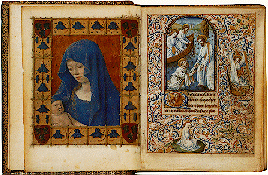Unlike most abstract that I have great difficulty producing, this one I found to be even more challenging because the main work is not yet complete. It is only about 3/4th done so I relied on my notes to guide me to the end.
My Pear Poet project started many years ago when E. Condren gave me an amazing idea a few weeks before graduation. I began my research and work on it immediately, but due to various circumstances, after leaving school did not pursue it further. While E. C. and I didn’t always agree (we were both quirky, but in different ways), namely because my fascination was mostly towards the physical manuscripts (which I believe some would refer to as “object fetishism” or something like that), and less concerned with the thematics. Not always, mind you, but if I had to pick between writing a paper about what scribe wrote what/ where/when, and tracing the narrative, the former would always win. In fact, some of my lengthiest works trace thematics in terms of the physical manuscripts, using the evidence found there as proof of how the story should, or was intended to move. Yet while he didn’t share my enthusiasm, he always encouraged it, and presented me with an opportunity that, despite having taken the better part of a decade, is finally going to be finished.
Per usual, whenever I finish different sections of notes or rough drafts I post them online, so the first two parts of this can be found in the Chaucer Project section. The third part will be finished at some point this week. The fourth, and longest section, will take a bit more time. Unfortunately the deadline for this abstract cannot wait for me to fully put everything together.
Abstract of work yet to be titled (oh dear!):
Experience versus authority is perhaps the clearest distinction that can be made between Chaucer and the Pearl Poet when considering an extended survey of each of their works. While the Pearl Poet’s works have survived in only one extant manuscript, the Cotton Nero A.x., Chaucer’s works for the most part abound (as much as 600 year old manuscripts can). Here I will be looking at all four of the Pearl poems, Pearl, Purity (Cleanness), Patience and Sir Gawain, and four of Chaucer’s works, The Book of the Duchess, Parliament of Fowls, House of Fame, and Troilus and Criseyde.
Despite critical arguments against his formal training, the Pearl poems are written with the authority of a man speculatively devoting his entire life to learned scholarship, most likely within the confines of a monastery, and far removed from worldly concerns. Nevertheless, his poems are entrenched in theological debate, exposing human nature’s incapability to understand the divine completely. He elevates his text beyond the apparent words, and constructs his poems within the confines of an intricate numerical design that serves to distinguish further between the worldly concept of language and the superior mathematical proportion symbolic of Heaven. Chaucer’s four poems, albeit complex and powerful in their own right, depict another aspect of literature: the creative endeavor, less concerned with perfection in terms of a numerical design, and much more inclined towards the human condition, emotion, and otherwise familiar affairs. This in no way negates the thematic effects of the Pearlpoems, or the numerical design within certain Chaucerian works, but merely shifts focus towards a more predominant theme, and aligns a Chaucerian plot to Cotton Nero A.x’s inclination towards mathematical unity, essentially superimposing experience over authority, and combining them to create a whole.
The two sets of poems represent the same world through two lenses: a theological one, highly appropriate for a supposed monk, and a more cultural stance associated with a courtly patronized man like Chaucer. Without much divergence from the interiority of the poems, a quick glance should immediately signal a pattern of three smaller poems directly related to the grand narrative closing each quartet, and if taken a step further, the same analysis is not only within the quartets as wholes, but constituent poems as well. Such an interpretation would group the poems in two ways – interpoetic and intrapoetic – in the end essentially binding the divine and worldly with each poem and providing a different piece of a larger puzzle.
The Pearl poems exhibit an unbroken consistency, and contain a group of favored themes such as patience and humility set against pride, earthly and heavenly courtesy, purity, and perfection. Similarly, dream visions guide Chaucer’s works, not serving to exemplify perfect Christian conduct, but instead reappearing to depict human folly. Yet it is this human folly, spiritual or worldly, that is the link between the eight poems, as humans by nature are imperfect and constantly erring. Whether it is a numerical design that illustrates what text cannot achieve or Pandarus’ third person presence in an intimate scene highlighting Troilus’ ineptitude, the two poets persist in reminding the reader of what different situations should be like while pointing towards where they fall short.
